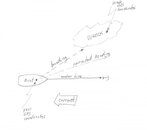Absent a marker buoy on the wreck, a fish finder or other sonar would be your best bet. Others have given you excellent advice for anchoring over the wreck assuming the GPS coordinates are accurate.
But GPS coordinates are often not accurate. Possible reasons are:
1. GPS Coordinates intentionally incorrect - Wreck divers, boat captains etc are often protective of a wreck site and if they publish a wreck site location they may put the location a mile or two off.
2. GPS Coordinates are older and taken at a time when for national security reasons there was a deliberate induced error in civilian GPS coordinates.
3. Since GPS does not work underwater the coordinates you have were either taken at the time of sinking and boats/ships don't drop straight down, or your coordinates were taken from a boat that had found the wreck and it may not have been directly over the wreck at the time it recorded the coordinates. So you can see why sonar, fish finder or magnetometer is a valuable tool.
4. This will surprise everyone (not!) but stuff underwater can and does move. This can include large ships. Storms, currents and shifting bottom structure can cause the wreck to creep over time.
5. If you have not found the wreck on previous dives, it is possible you are actually at the correct location and just don't recognize the wreck. Wrecks don't stay looking like a ship or boat forever underwater. If they are in shallow water they fall to pieces more quickly due to wave, surge and current action. If the wreck is older, it may be in pieces and present a fairly flat profile. Last wreck I visited was of a steel ship and the tallest piece was 3 feet tall. Steel plates all over the place. Don't forget that all sorts of marine live will cover the wreck too and that will add to its camouflage. You may be looking at a rock or other object underwater that is in fact part of the wreck covered in marine growth.
Hand held sonar the size of a D cell flashlight will help you on the surface and you can take it with you to assist in the locating the wreck underwater.
http://aquaviews.net/scuba-gear/hand-held-sonar-devices-for-scuba-divers/# These devices are relatively inexpensive with some priced at $99.95
Wal-Mart sells Hand held sonar (fish finder) that is NOT submersible for $62.89 and boat mounted fish finders (sonar) start at $74.26
http://www.walmart.com/cp/Marine-Electronics/5188




